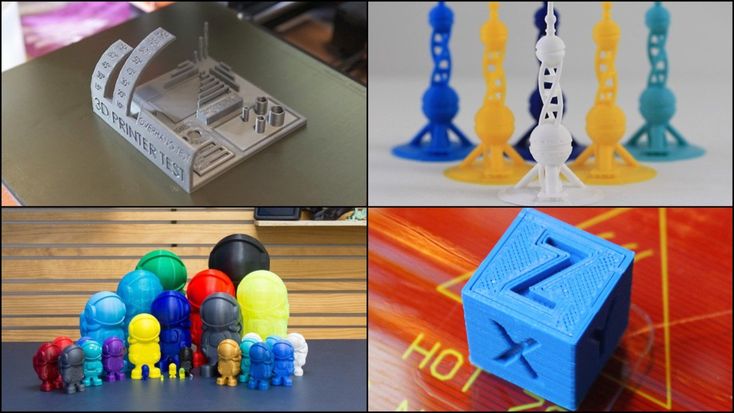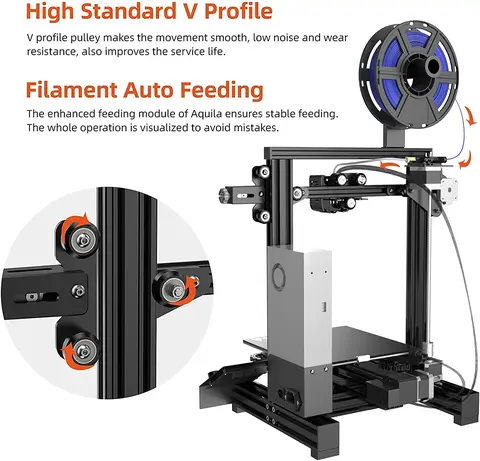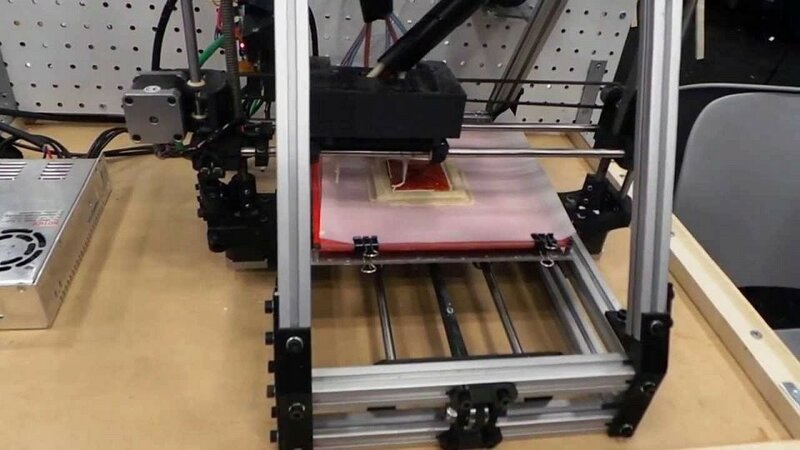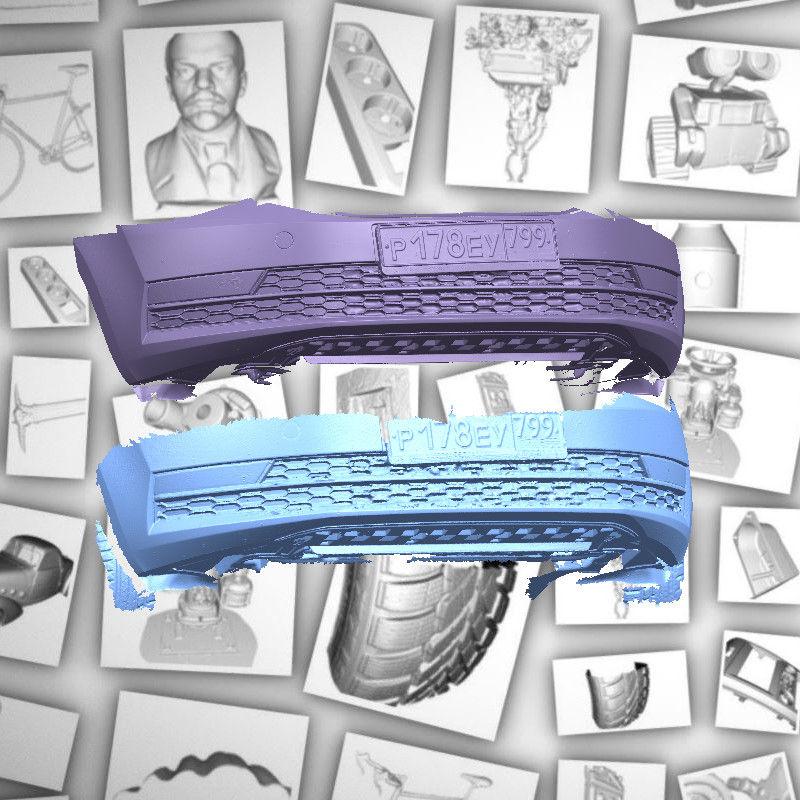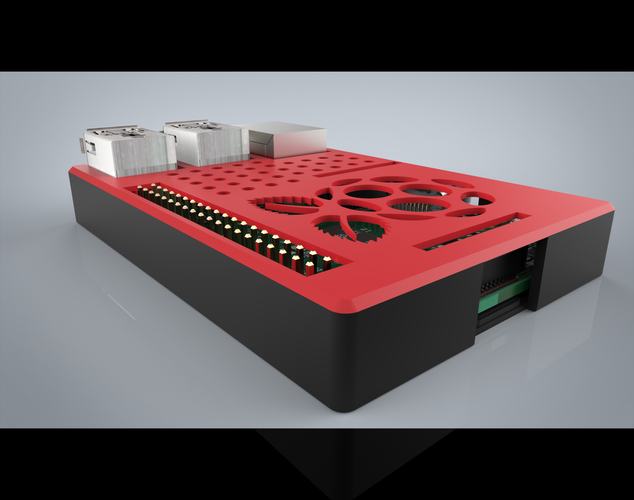3D printed hand cast
Are 3D Printed Casts the Right Choice for You?
A 3D printer may look like something out of a science fiction movie, but this cutting-edge technology is becoming increasingly common in the medical world. Now, a new use for 3D printing is emerging in the field of orthopedics. In particular, 3D printed casts are an alternative to traditional plaster or fiberglass casts.
While 3D printed casts are not yet widely available, they are becoming popular as more patients learn about the benefits that they offer. This blog post will discuss how 3D printed casts work and why you might choose one over a traditional plaster or fiberglass cast.
What Are 3D Printed Casts?A 3D printed cast is a medical device created using a 3D printer to support a broken bone as it heals. Unlike traditional casting, 3D printed casts are produced using additive manufacturing technology. This means that they can be custom designed to fit the specific contours of a patient's limb.
3D printed casts can be manufactured with an open design that allows the skin to breathe and helps prevent skin irritation. In addition, 3D printing technology makes it possible to produce casts in different colors and designs.
How Do 3D Printed Casts Work?phonlamaiphoto - stock.adobeA 3D scan is made of the injured limb to make the cast. This scan is then used to create a 3D model of the limb. An engineer uses that model to create a cast design that will fit the limb. The design is then sent to a 3D printer, which creates the cast using a high-temperature thermoplastic. The final product is then put on the limb and can be removed when the injury has healed.
Step 1: ScanThe process of creating a 3D-printed cast begins with taking a scan of the patient’s limb. This may include x-rays, CT scans, or other imaging techniques. This allows the doctor to determine the broken bone's exact position and the shape of the patient's limb.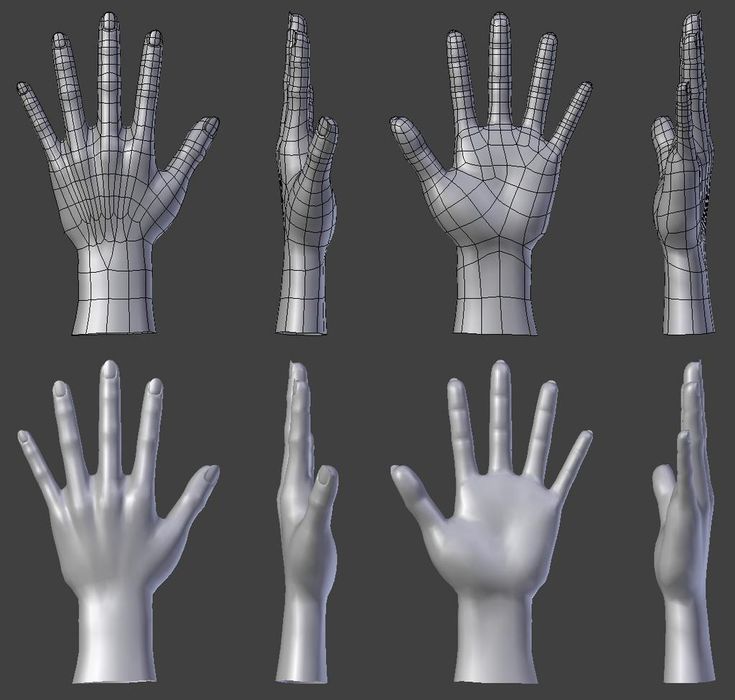
Once the scans are complete, a 3D model of the limb is created. The patient's hand is scanned with a 3D scanner to create an accurate and detailed three-dimensional model. This model can then be used to create a custom device design without the need for casting.
Step 3: 3D printingThe next step is to print the cast. This can be done using a high-temperature thermoplastic or by sintering powder. The print may require post-processing to make the materials safe to touch and strong to wear for long periods of time.
What Are 3D Casts Made Of?Most 3D casts are created using a high-temperature thermoplastic. The plastic is heated to a high temperature and then cooled, creating a hard, durable cast that can support broken bones or immobilize joints for non-surgical treatment. The exact composition varies depending on the manufacturer, but it typically includes a variety of polymers and resins.
3D-printed casts offer a number of benefits over traditional plaster casts or fiberglass casts, including a better fit, greater breathability, and decreased itchiness. They are much easier to remove, so you can wear them in showers or baths without worrying about this type of cast getting wet. They are also weather-resistant, so you don't have to worry about them getting ruined if caught in the rain.
Additionally, 3D printed casts can be custom-fit to your body, making them more comfortable to wear and less likely to cause skin irritation. Finally, because they are lightweight and breathable, 3D printed casts are less likely to cause swelling and discomfort than traditional casts.
Drawbacks of 3D Printed CastsAlthough they offer a number of advantages, there are also some potential drawbacks to consider. One of the main risks associated with 3D-printed casts is that the cast may not fit properly if the limb is swollen during the initial scan.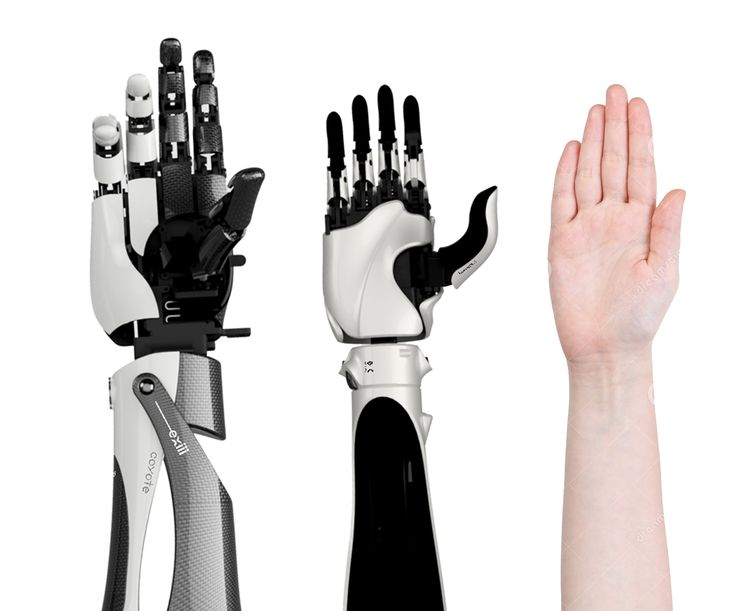 When swelling occurs, the affected area can increase in size, which may cause your print to not fit properly. The process will then need to be repeated, which can be both time-consuming and costly.
When swelling occurs, the affected area can increase in size, which may cause your print to not fit properly. The process will then need to be repeated, which can be both time-consuming and costly.
Another limitation is that 3D printed casts are not suitable for patients who need immediate care. This is because it can take some time to create and process the print, which may not be practical for patients with serious fractures. Additionally, 3D printed casts are not suitable for patients who require manipulation of the bones back into place.
The last disadvantage to consider is that 3D printed casts are more expensive than traditional casts, and insurance companies may not cover the cost. Although this technology is constantly improving, it is important to be aware of the potential disadvantages before choosing a 3D printed cast for your injury.
3D Printed Casts Costphonlamaiphoto - stock.adobeAlthough 3D printing technology is often associated with a low-cost manufacturing process, the reality is that the cost of 3D printed medical devices can be quite high. When it comes to the cost of 3D printed casts, there are a few key factors to consider.
When it comes to the cost of 3D printed casts, there are a few key factors to consider.
First, the materials used in 3D printing are typically more expensive than traditional plaster or fiberglass. Second, the scanning equipment required to create a 3D model of the injury can be fairly costly. Finally, most hospitals or clinics would need to hire additional personnel to operate the 3D printers to create the designs or hire an outside firm to complete the tasks.
Overall, the cost of 3D printed casts is likely to be higher than traditional casting methods. However, it is worth noting that the price may come down as the technology becomes more common. Additionally, some insurers may start to cover the cost of 3D printed casts as they become more widely used for bone fractures.
3D Printed Cast CareWhen it comes to caring for a 3D printed cast, the process is quite simple. Unlike traditional plaster or fiberglass casts, which must be kept dry at all times, 3D printed casts are water-safe and can be fully submerged. This makes showering and bathing easier for patients, as they no longer need to worry about keeping their cast dry. Wounds are visible through the material of the 3D-printed cast, and they can be monitored at all times.
This makes showering and bathing easier for patients, as they no longer need to worry about keeping their cast dry. Wounds are visible through the material of the 3D-printed cast, and they can be monitored at all times.
While 3D-printed casts have been hailed as a game-changer in the medical field, they still have several drawbacks. Cast21 was developed as an innovative solution to overcome the problems of current casting technology.
FDA listed, the Cast21 system is the next generation of cast technology. The injured limb is simply placed into an open lattice sleeve and filled with a fast-curing proprietary formula. This patented system creates a perfect-fit, fast-acting solution for joint care. The result is a strong, yet seemingly weightless cast alternative that is comfortable to wear. In addition, Cast21 is waterproof, so patients can easily shower, and swim allowing patients to stay active while they heal.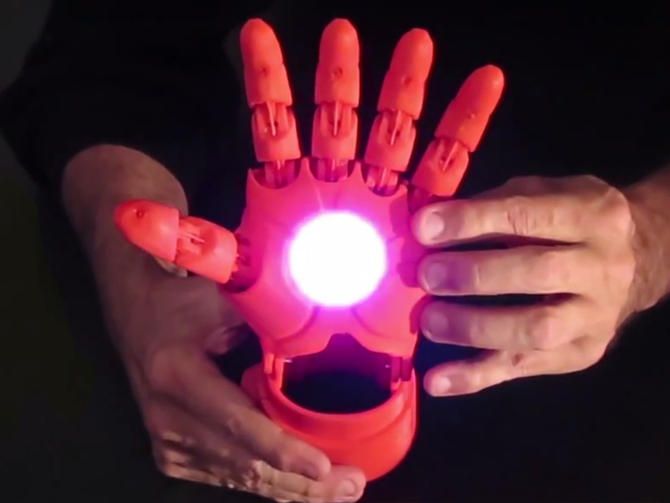
With its unique design and versatile applications, Cast21 is changing the way we think about healing. It's no wonder that Cast21 is quickly becoming the preferred choice for patients and doctors worldwide.
How to design custom, 3D printable braces for arm injury
Traditionally, casts for broken bones are made from heavy, solid, non-breathable plaster. This can create discomfort and skin problems for the patient during the healing process, like itchiness, rashes and skin infections. Custom 3D printed casts made with a breathable, voronoi pattern are a potential DIY solution. This method is obviously not medically approved (as yet) and shouldn’t be used in place of seeing your doctor. However, if you normally wear a wrist split/other brace for injury you could create your own custom version of this with approval from your occupational therapist or specialist.
While this is a great potential solution, 3D modelling and 3D printing a custom cast or brace is time consuming.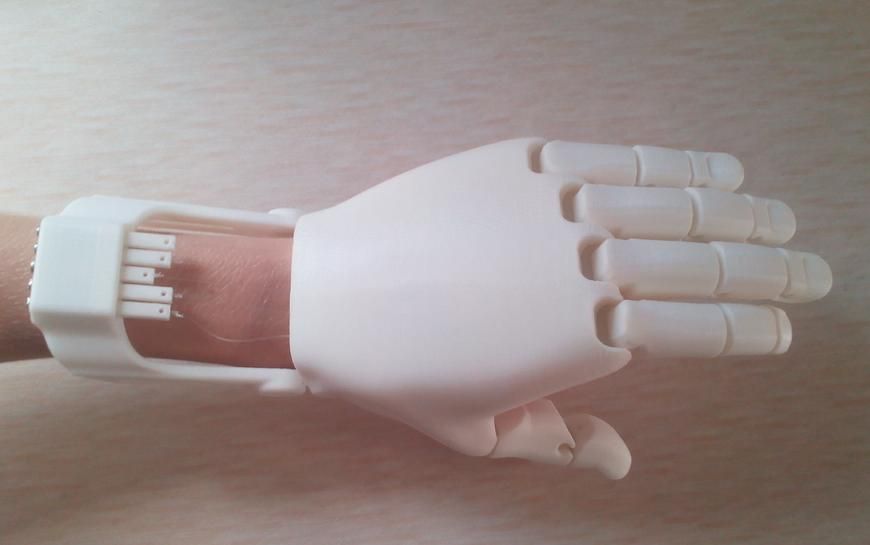 A standard 3D print of a wrist cast takes about 3 hours to print on a 3D printer, where plaster tends to take about half an hour to fit to a patient and is very cost effective. This method is a DIY solution for experimentation only. I’ve previously blogged on how to create Wrist Braces using Meshmixer, this method is more complex but has a better result and a better fit.
A standard 3D print of a wrist cast takes about 3 hours to print on a 3D printer, where plaster tends to take about half an hour to fit to a patient and is very cost effective. This method is a DIY solution for experimentation only. I’ve previously blogged on how to create Wrist Braces using Meshmixer, this method is more complex but has a better result and a better fit.
To make one of these, you’ll need a 3D scanner and a copy of Meshmixer and Rhino 3D software, with Grasshopper, the algorithmic modeling plugin installed.
First, you’ll need to take a good scan of the area you’d like to make a brace for. I recommend asking ‘patient’ to hold their arm out and resting the fingertips on something to stop the arm from involuntarily shaking. Import the 3D scan into Meshmixer, and use the Plane Cut function to cut away the areas you do not want, i.e. the fingers, thumb and arm. You may also want to do some cleaning with the brush tools depending on the quality of your 3D scanner.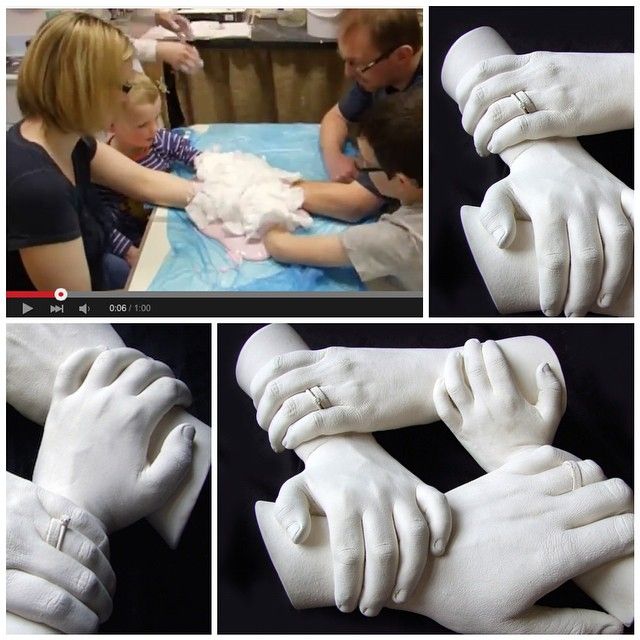
Next, import your trimmed arm model into Rhino 3D. Use the function MeshtoNURBS to convert the .stl into a polysurface. Create an array of roughly spaced surface planes to fit the length of your scanned model, like the images below.
Next, use the function IntersectTwoSets and highlight first your surface planes, and then the arm model. You will create a series of ‘plane cut’ style curves like the image below.
Sometimes these curves will come out a bit irregular. Use the function _Rebuild on the curves to fix this. Next, use the Loft function to create a new surface using the arm curves. You’ll need to select the curves in order for this to work correctly.
Next, use the function OffsetSurf to create a surface 2mm above the existing surface. This will make sure the brace will sit nicely on top of the skin. You can also cut the brace in half by using the Boolean split tool.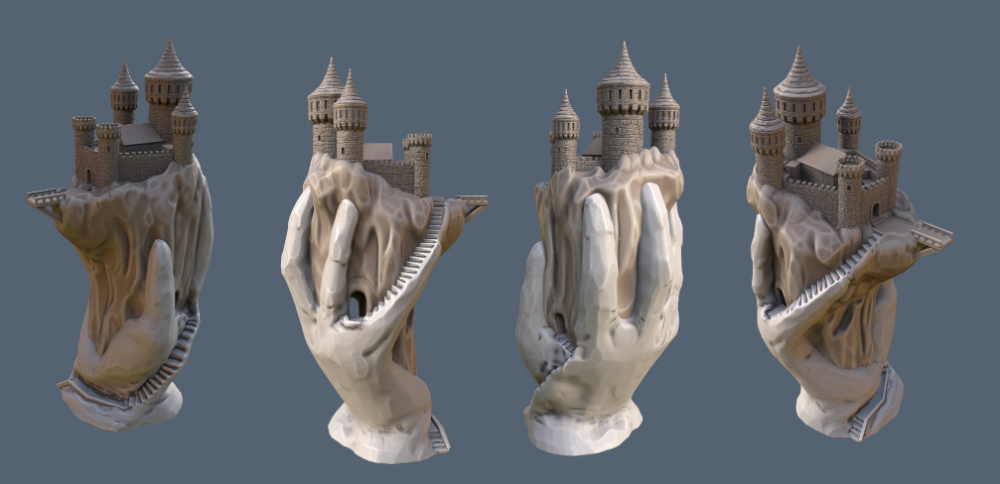 Launch Grasshopper for the next step. You’ll need to download this Voronoi algorithm and open it in Grasshopper.
Launch Grasshopper for the next step. You’ll need to download this Voronoi algorithm and open it in Grasshopper.
Right click the first Brep input component of the algorithm and select Set one Brep and click on the first half of the brace when prompted. This will now map a voronoi pattern to the offset arm scan. You can go through the algorithm and tweak different aspects, including the hole size and more.
After you’re happy with the outcome, highlight the last section of the algorithm, right click and choose Bake.
Repeat the process on the other half of the brace. You now have a voronoi brace!
You should be able to print this standing upright without any supports. You can use ribbon and beads to act as a hinge, or 3D model on a hinge of your own design. Xkelet has some great designs for inspiration. Enjoy!
how to make it? How to make your own plaster hand for copying
The memory of unforgettable moments of childhood can be left not only by photography, but also by modeling gel for casts , used to create precise outlines of your baby's legs or arms.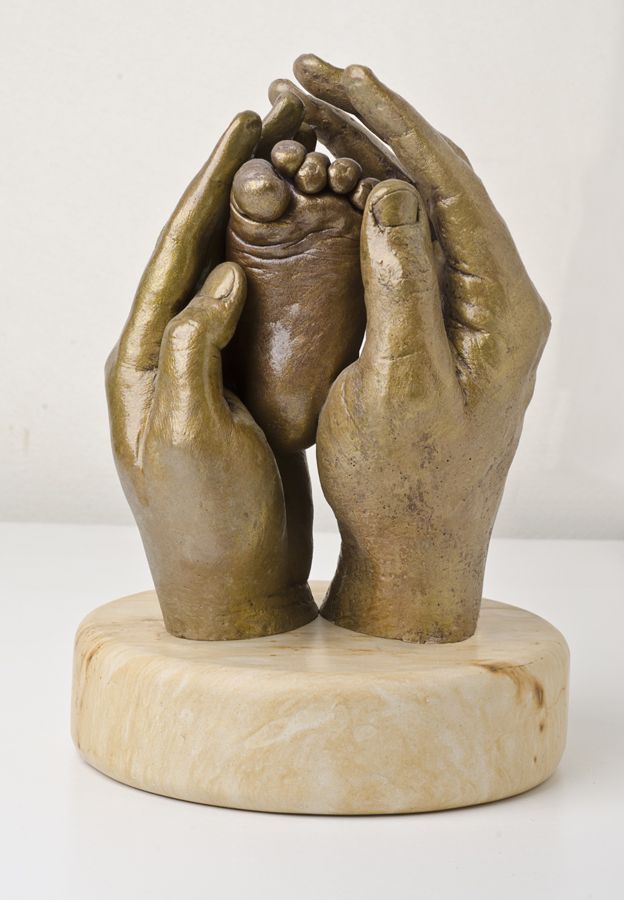
Not only parents buy today, but also godparents, grandparents, who want the imprint of unique little children's hands to remain not only on paper.
With the help of the gel, you can create an impression that conveys the smallest details of the child's hand.
Modeling gel is also used to create an exact shape that conveys lines, curves and other minute subtleties of the body.
You can order the work of a master for making impressions. Some of them also work in the creation of cast paintings - this is a beautiful creation that will be interesting to you and the child when he grows up.
If necessary, you can purchase your own impression gel and perform the entire procedure yourself.
Instructions for use are usually included with the packaging. The most common modeling gel is offered by many companies, including Arms and Legs and Socrates.
To create a 3D cast, you no longer need to look for a sculptor or other master in this direction, as you can purchase a special model gel designed for a certain age of the child and create a unique painting or sculpture reminiscent of the child's childhood.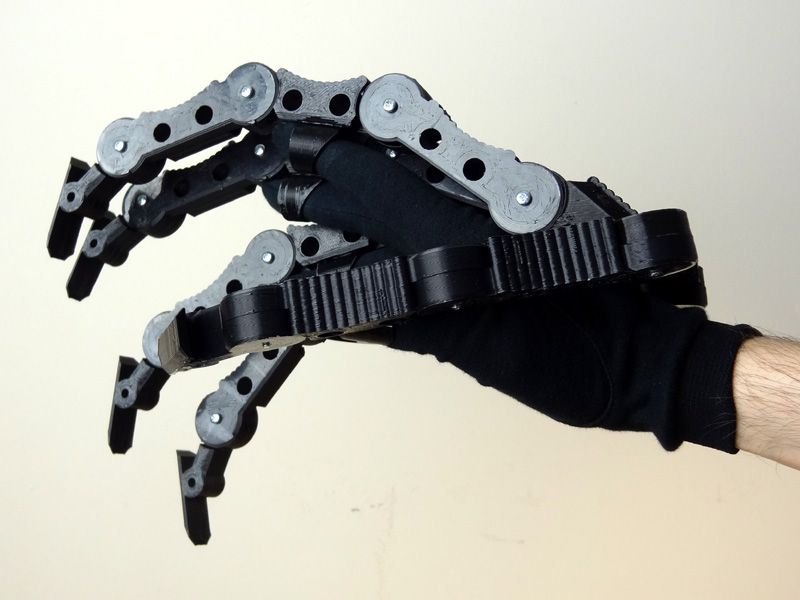
It will take no more than half an hour to create an impression, if you carefully follow the instructions in the instructions.
Some sets also include postcards, on which you can later place the created impression. Or you can pre-buy a frame in which the photo of the child will be placed.
The step-by-step process for making impressions is quite simple and clear:
- Initially, you need to dip the arm or leg into the modeling gel, which sets quickly. Creating a form in this case will take about 2 minutes. Moreover, do not worry that the consistency can cause allergies, as it is completely safe even for the smallest. The unique gel preserves not only the original size of the palm, but also repeats all the subtleties of lines, nails, and folds.
- After that, a high-precision modeling plaster must be poured into the resulting mold.
- After approximately two hours, the sculpture must be freed from the model material and thus an absolutely exact copy of a small handle or leg should be obtained.
 If desired, such a sculpture can be decorated in any way: coated with varnish or other coating, make an inscription, decorate with some decorative elements.
If desired, such a sculpture can be decorated in any way: coated with varnish or other coating, make an inscription, decorate with some decorative elements.
Recently, many couples in love have also become interested in this gel.
Such a surprise will surely please everyone, even not an avid romantic.
You can buy 3D gel for casts in a wide range in many chain stores or on Internet portals. A set consisting of gel and plaster must be certified, like any other product.
The presence of instructions is also important, although they may not offer it - they sell only gel bags that have a lower cost compared to the full set.
When purchasing a model gel, do not forget to provide the amount of material, which can be calculated by the website consultants.
Naturally, it is advisable to buy 3D gel for casts from trusted companies, especially if you want to make a cast of a child's hand, since everyone can guarantee the safety of the composition, but how it actually exists is not known.
Do not miss the opportunity to get a unique family heirloom, the unusualness of which will attract and constantly remind you of a certain moment in your life. In addition, the cost of model gel for casts is loyal, so anyone can buy it.
To make a trace of the arms or legs of your baby, that is, the first trace of the crumbs, you must read this instruction.
All materials intended for making impressions do not cause any harm and cannot cause .
For their manufacture, a small amount is required, this will not disturb the child, because the technology by which the casts are made is innovative, and the composition from which the cast will be made is hypoallergenic.
Specialists have specially developed kits so that parents can create children's casts on their own.
Often the parents of children bought kits in stores, but there was not enough molding mass for a sufficient number of casts. But there are kits with which parents have several attempts before the real start.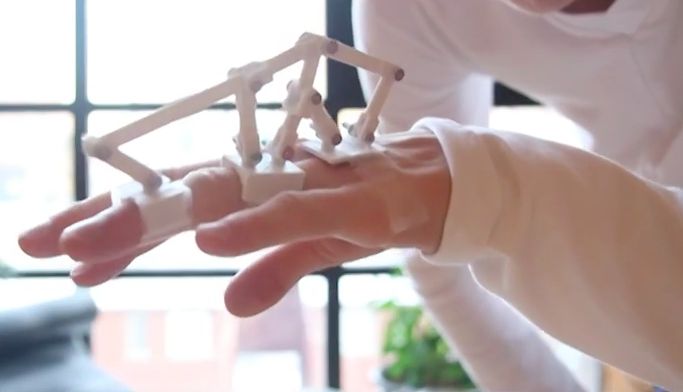 They train and begin to sculpt something really beautiful and neat. It turns out a quality cast. They can create it not only for themselves, but also as a gift to grandparents, godparents of their little one, make casts of children of close friends as a gift to them.
They train and begin to sculpt something really beautiful and neat. It turns out a quality cast. They can create it not only for themselves, but also as a gift to grandparents, godparents of their little one, make casts of children of close friends as a gift to them.
In addition to making casts of the tiny limbs of your little one, you can create a cast of the hands of two lovers or newlyweds, a cast of your own hand.
Today there is a great abundance of such things on sale, with the help of which it is easy to create your own design of casts.
And on the Internet there are many samples for making casts.
If you want to put the resulting cast on a table or shelf, you need to fill a plastic mold, for example, from under sweets, with plaster, paint it with any paint, then glue the resulting cast of a leg or handle with a good glue.
3d impression kits
Watch a video on how to create a cast correctly:
Now let's take a closer look at this video: mix the dry gel in the required proportion, beat with a mixer until a homogeneous mass is formed, convenient for use. After that, we lower the child's leg into the mass, take it out. We fill the form with special plaster, after a while we take out the resulting sculpture.
After that, we lower the child's leg into the mass, take it out. We fill the form with special plaster, after a while we take out the resulting sculpture.
Pretty easy, isn't it?
And now let's take a closer look at the proportions by which you need to mix water with the impression gel.
Take 100 grams of dry gel, also 400 milliliters of water. Well, to create the hand of an adult, instead of a mayonnaise bucket, they take a two-liter bottle of plastic, cut off her throat. Take 250 grams of gel per liter of water.
For children aged between and above, you need to calculate the proportions yourself. To do this, measure the amount of water required to completely immerse the child's arm or leg in the container.
In order to pour the mold, take a special plaster. To pour one cast, take ten to five tablespoons of gypsum and 0.05 liters of water.
In order to pour one cast of an adult's hand, you will need 20 tablespoons of gypsum and 0.18 liters of water.
2d impression kits
Making a convex cast of some part of your little one's tiny limbs.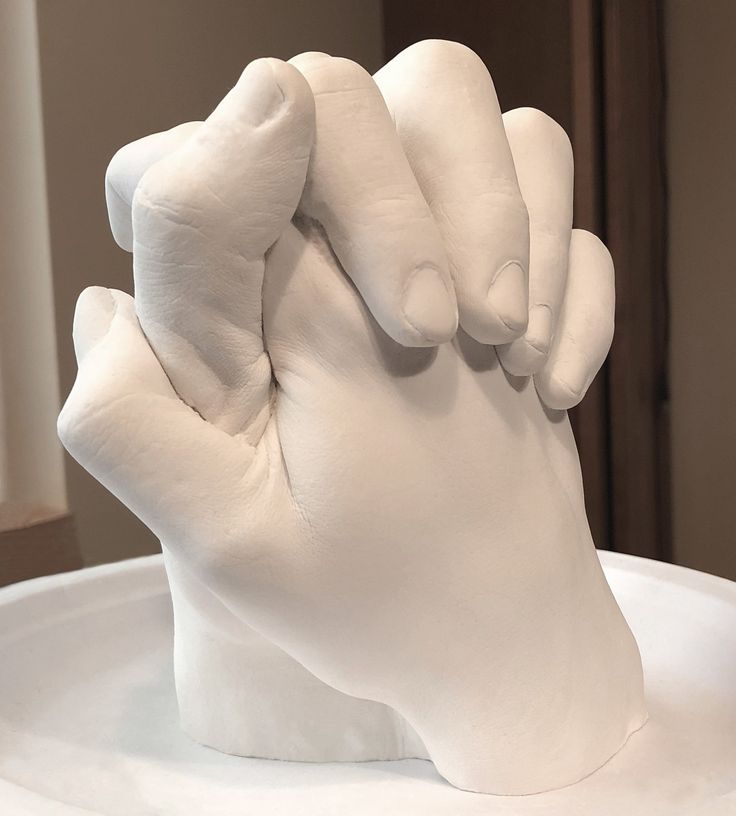
This technology assumes a plastic material for reusable use.
It is quite plastic and soft, able to convey every fold and line of the skin, keeps its shape perfectly.
But this material can be used almost unlimitedly.
The main condition for storage is the obligatory presence of the material in a jar, the absence of contact with water, talc and oil.
This kit will help you make casts of baby feet and hands every month. You will compare how the baby has grown.
And now the video instruction for making impressions 2 d:
When analyzing this video, we want to clarify again that the convex layer of the handle is made using the finished impression mass manually, filled with special plaster. Then everything dries up, the cast is pulled out, the mass is again kneaded. A new cast is created from it.
After this procedure, the impression mass is kneaded again, it is placed in a bag into which air will not enter, in order to take out the mass next time and create a sculpture again.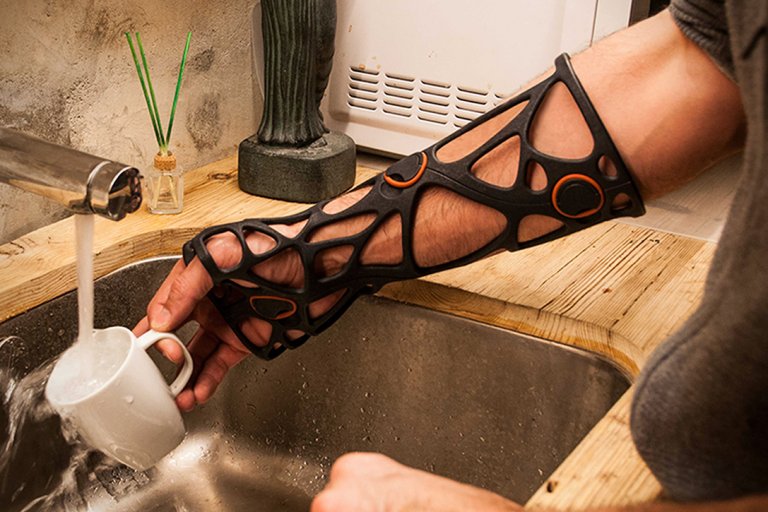
Casts can be stained in any color you like. This can be done using watercolor, gouache, acrylic. Glue what you got to the photo frame. At the same time, use any decor that you like, some collages, booties, a tag, a dummy, an ultrasound scan, a bodysuit, a vest, a hat. The main thing is to use your imagination.
Available to everyone. A casting made in accordance with all the rules and in compliance with the proportions when mixing the working solution will turn out to be very realistic.
The appearance of the finished product and its strength characteristics will depend on the quality of the gypsum. To achieve maximum similarity, a quality form is needed. For its manufacture, special materials are used.
Idea
For those who are in love, a plaster cast of a pair of hands intertwined together can serve as a gift for a significant date. Often such a composition is ordered by newlyweds on their wedding day.
Children's casts of hands and feet are ordered by parents as a keepsake in addition to photos and videos with their babies.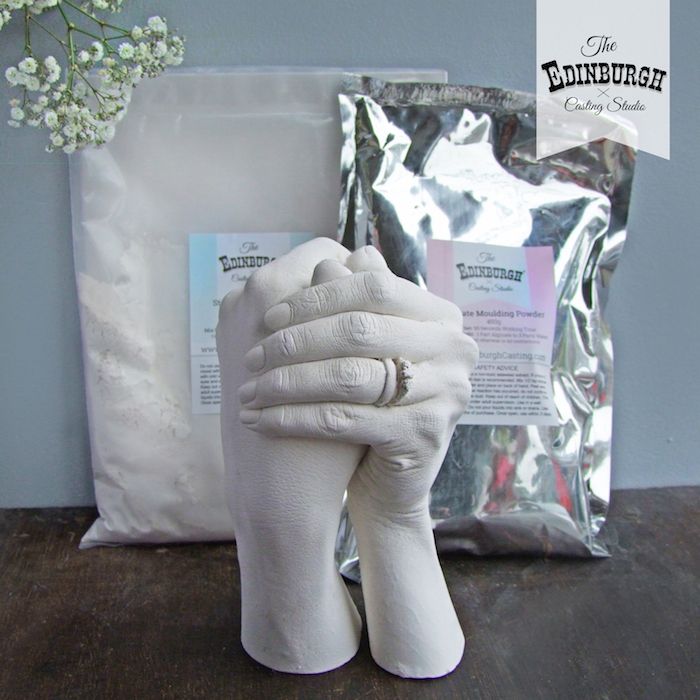 Such a souvenir, decorated in an elegant frame, can be presented to relatives and friends as a memory of a memorable date: the first or anniversary birthday, baptism, the first independent step of a child, etc.
Such a souvenir, decorated in an elegant frame, can be presented to relatives and friends as a memory of a memorable date: the first or anniversary birthday, baptism, the first independent step of a child, etc.
You can create a whole collection of such casts made in different periods of active child's growth. Later, holding them in their palms, children may remember the happy moments of their childhood.
An elegant plaster hand, made and decorated with your own hands, can also serve as a detail of the original composition. Such a decoration, for example, can also be used as a mannequin for storing rings.
Gypsum
There are many different materials for mold casting. These are paraffin, wax, concrete, silicone, metals, even chocolate can be poured into a food form. Compounds of plastics, resins have now become available. All of them have their own specific casting features. To answer the question of how to make a plaster hand, you first need to understand what kind of material it is.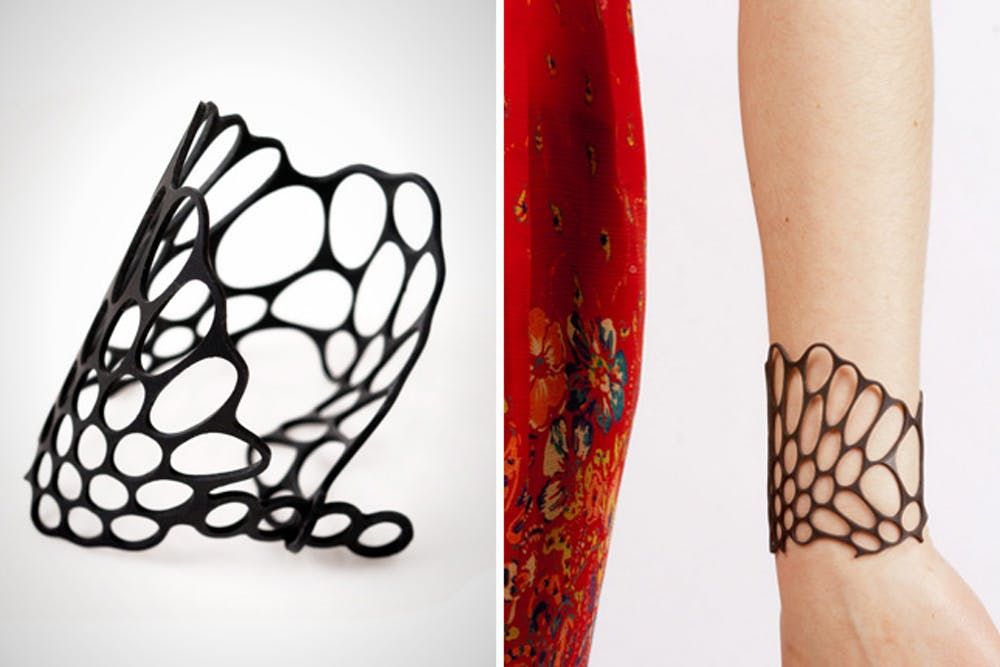 It is also important to understand the technology of its casting.
It is also important to understand the technology of its casting.
Gypsum powder is a natural material. It has a white or grayish color, fine grinding, quickly absorbs moisture when water is added. It is obtained by firing gypsum stone and is distinguished by its purpose: for medical purposes, for molding, for plastering and the production of plates.
Construction gypsum has a coarser grinding, medical gypsum is the purest, molding gypsum sets more slowly. A useful property for sculptures is an increase (up to 1%) of the working composition in volume. This extension makes it possible to fill in a small drawing of a form. When preparing the mortar, after a few minutes it begins to harden and completely seizes within 20 minutes.
Technology features
Gypsum powder must be stored in a dry place. Soaked or damp material is not suitable for casting, it does not set. Its characteristics also deteriorate from long-term storage. The working solution of gypsum is prepared quickly.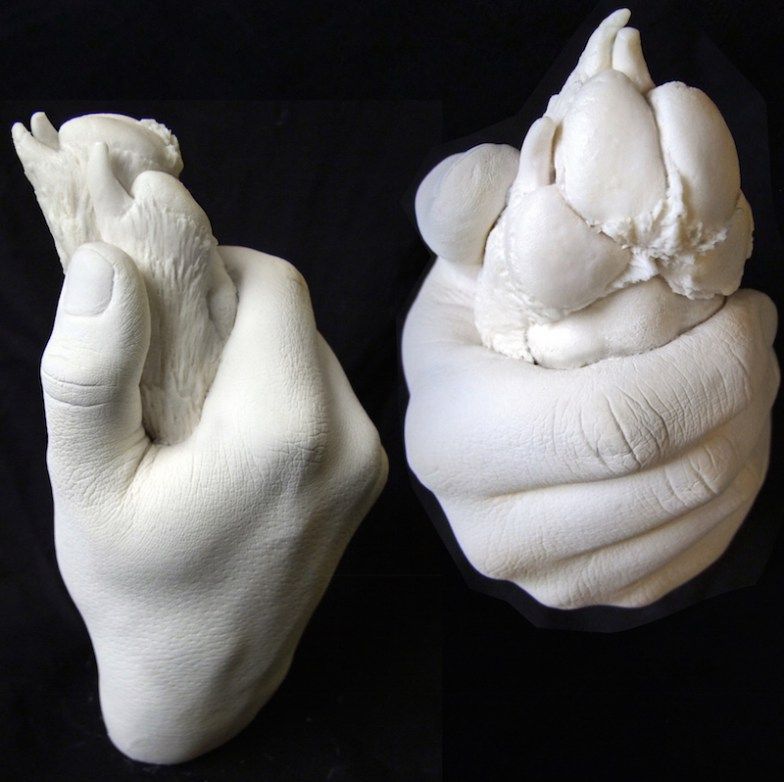 From prolonged mixing, it “rejuvenates” and seizes weaker, which ultimately leads to a loss of strength of the finished product.
From prolonged mixing, it “rejuvenates” and seizes weaker, which ultimately leads to a loss of strength of the finished product.
If the working solution has hardened before the completion of pouring, it is no longer suitable for work. Adding water and re-mixing it will not fix the situation. Liquid glue can help slow down the setting of the solution. It (3-4 tablespoons per bucket of water) is added beforehand and mixed well.
It is necessary to dry the casting at a temperature of up to 60 degrees. It is not desirable to exceed this limit - the material loses its strength and begins to decompose. Do-it-yourself gypsum hand is made taking into account all these nuances. To make the finished product stronger, the solution is kneaded with milk of lime.
Moisture and dampness adversely affect plaster products, so they must be used and stored indoors, especially if they do not have a protective coating.
Preparatory operations
Making a plaster hand on your own is possible at home without the use of any special technologies and special equipment.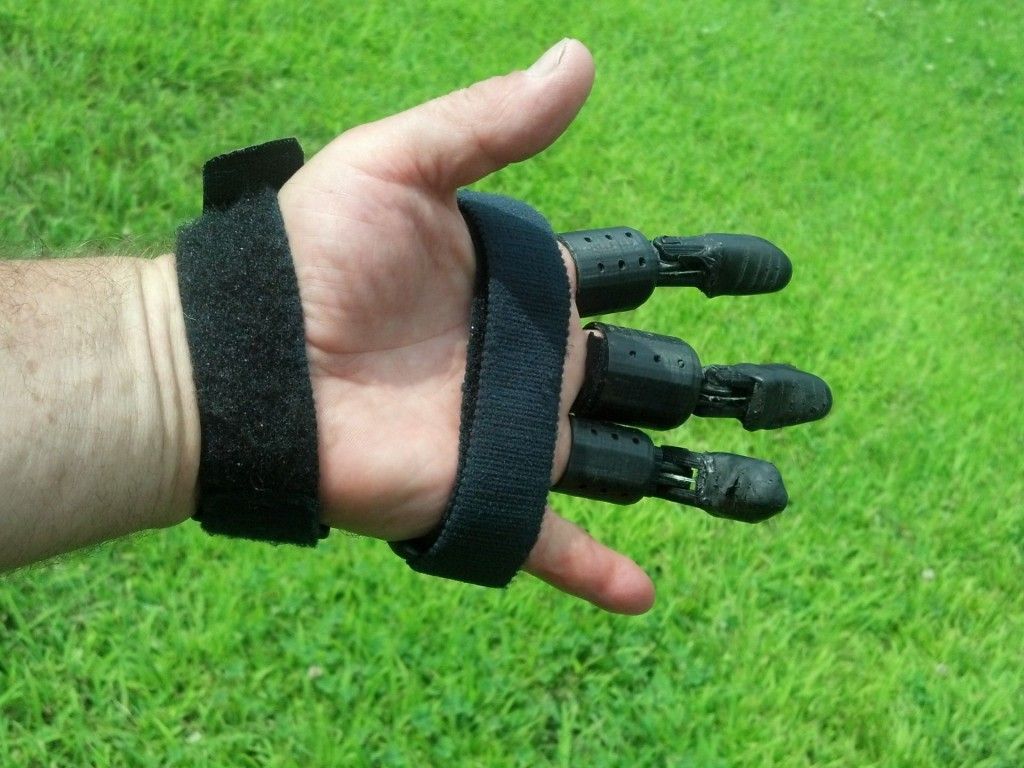 However, for the casting process to go smoothly, you need to carefully prepare. Different batches of gypsum (especially building gypsum) may have different setting times.
However, for the casting process to go smoothly, you need to carefully prepare. Different batches of gypsum (especially building gypsum) may have different setting times.
To know it exactly, it is best to test mix and pour a small amount of mortar into any simple mold. This will allow you to accurately calculate the proportions of gypsum and water, determine the time period within which the solution retains its casting properties. As a result, this will help save material, time and nerves.
At the preparation stage, they determine the container for the mold, as well as select a suitable vessel for mixing the gypsum mortar. For a one-time filling, you can take disposable dishes. If you plan to continue casting, it is best to purchase a rubber plaster to mix the working solution.
Half of an old children's ball is suitable for this purpose. Dried gypsum from the walls is easily peeled off when the rubber is deformed. The skin of the hand that will be immersed in the molding mass can be lubricated with a thin layer of castor oil or petroleum jelly.
Simple clay mold
A test plaster cast of a hand can be successfully cast into a clay mold. This will not be a full-fledged volumetric copy, but it will provide an opportunity to get the first practical experience. Clay is an affordable material that can be reused many times after failed attempts, which is just right for beginners.
We need two pieces of board or plywood 5 cm larger than the palm of our hand. They and the hand are smeared with vegetable oil or vaseline. This is necessary so that the clay does not stick. They put a hand on the board with the palm of their hand, press it tightly and begin to apply clay moistened with water and kneaded to a thick dough, kneading it well and compacting it.
The total layer should be at least 5 cm. Its top is leveled on a plane and covered with another board. The whole structure, together with the hand, is carefully turned over. The bottom board is removed and the palm is carefully released. The form for filling is ready. To obtain ideal castings, plastic molding masses are used.
To obtain ideal castings, plastic molding masses are used.
Impression alginate
Special formulations are used to make complex molds. One of the most affordable options is alginate mass. Its main purpose is the production of casts in dental practice. But such material is quite suitable for sculptural castings.
Alginate is a raw material from seaweed. Its dry powder, mixed with water in exact proportions, quickly thickens and acquires the properties of a dense jelly. If, before the start of the setting process, a hand is placed in such a mass, and then, after reaching the optimum density, it is carefully removed, then a cavity is formed in the mold. If a plaster solution is poured into it, then after hardening it forms an exact copy of the hand.
Casting cannot be removed without breaking the mold. The alginate mass is in a state of plasticity for a short time, it begins to lose moisture, becomes brittle and collapses from deformation. Therefore, filling with a working composition should be done immediately after removing the hand.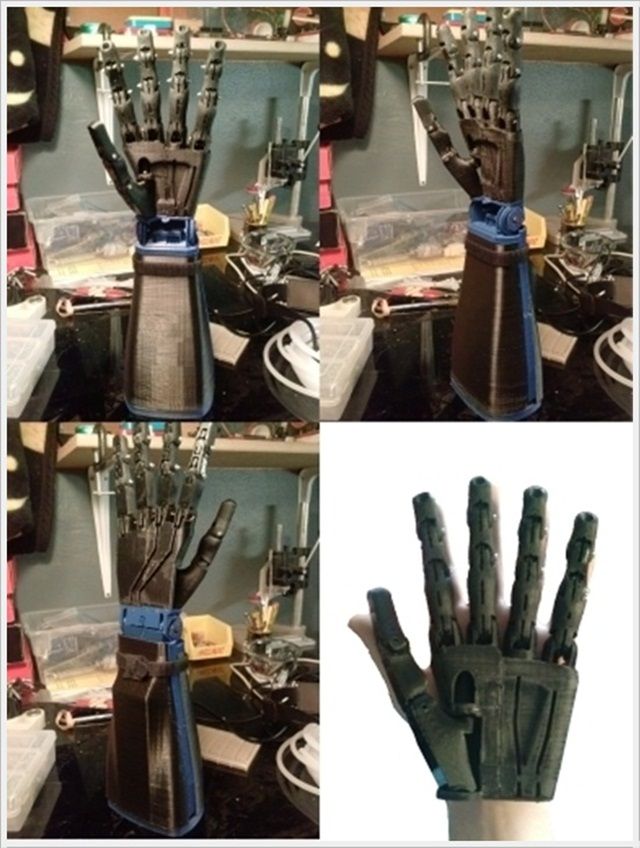 In this case, you can expect a high quality cast copy.
In this case, you can expect a high quality cast copy.
Some grades of alginate masses change color as they cure. When kneading, they have one shade, in the initial phase of setting (the optimal moment for immersing the hand) - another, after reaching density (when you can remove the limb) - the third. The process of making a plaster hand with the help of such a molding material is within the power of anyone.
Mortar preparation
Do-it-yourself plaster hand is cast in a pre-prepared mold. Pure cold water is collected in the mixing container in the required amount. Dry gypsum powder is evenly poured into it. Ideally, it should form a hill above the surface.
Gypsum begins to absorb water intensively. At this time, it must be well stirred. This should not be done too intensively, as air bubbles form. They remain in the solution, get into the mold, and after it hardens, they form shells and cavities. Therefore, you can use a drill with a kneading nozzle only at low speeds.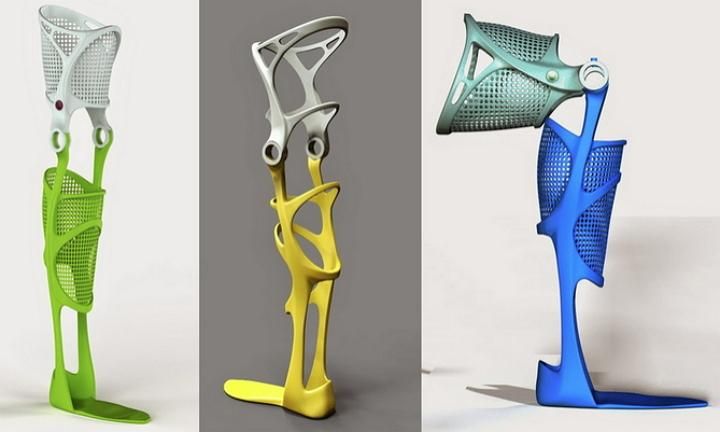 It is better to do everything by hand, using a spoon or a wooden stirrer. The goal is to get a homogeneous mass without lumps, resembling sour cream in density.
It is better to do everything by hand, using a spoon or a wooden stirrer. The goal is to get a homogeneous mass without lumps, resembling sour cream in density.
The proportions of water/gypsum (approximately one to two) are determined experimentally in advance. After mixing, the container is lightly tapped to release air bubbles to the surface. The resulting foam is collected with a spoon. The prepared working solution is immediately poured into the mold. The time from the beginning of mixing to pouring is no more than a minute and a half.
Casting into a mold
Do-it-yourself plaster hand is made by casting into a prepared mold. The solution is added in portions. If they fill out a complex form at once, then air sacs can form in it. The gypsum mortar does not fall into such voids; as a result, the finished model will have defects.
To avoid this, the mold is rotated in all directions after pouring the first small part of the working solution. So it spreads over the inner surface and falls into all the recesses. The air inside does not accumulate and is gradually forced out.
So it spreads over the inner surface and falls into all the recesses. The air inside does not accumulate and is gradually forced out.
With the next portion, the gypsum mortar is deposited on the walls more and more, its layer becomes thicker. When complex undercuts are completely filled, you can pour the rest of the gypsum.
The process of making an impression of a child's hand is slightly different from the workflow with adults. The fact is that the child, as a rule, cannot keep his hand in a constant position until the molding mass seizes. Finger movements during molding spoil everything. Therefore, it is best to carry out this procedure during sleep in its deep phase.
Alginate molding material is used. It is kneaded in a bowl of a suitable size. All components are prepared in advance according to the instructions. Alginate powder is poured into the water and stirred with a spoon until smooth for about one minute.
Adults use cold water. But so that the child does not wake up during sleep from contact with a cool mass, it is better to warm it up. Warm water for mixing significantly reduces the time of use of the molding material, so everything must be done quickly.
Warm water for mixing significantly reduces the time of use of the molding material, so everything must be done quickly.
When the formula is ready, it is poured into a suitable glass, matched to the child's arm, and the child's limb is placed there. The hardening time of the mass is 1-2 minutes. During this period, you need to keep the form at rest in order to get a quality print.
After the allotted time, the infant's arm is gently removed. As a rule, this happens without problems, since the mold is plastic and does not deform from light loading.
Immediately after this, the working solution is prepared and poured. Gypsum is kept in the mold for no more than 30 minutes. Later, the alginate mass begins to give up water, which will adversely affect the casting. The form is removed from the glass, cut into pieces, the plaster handprint of the child is released. It is cleaned and left to dry.
The same principle is used to cast the hand of an adult or a child who can keep the hand still during the molding.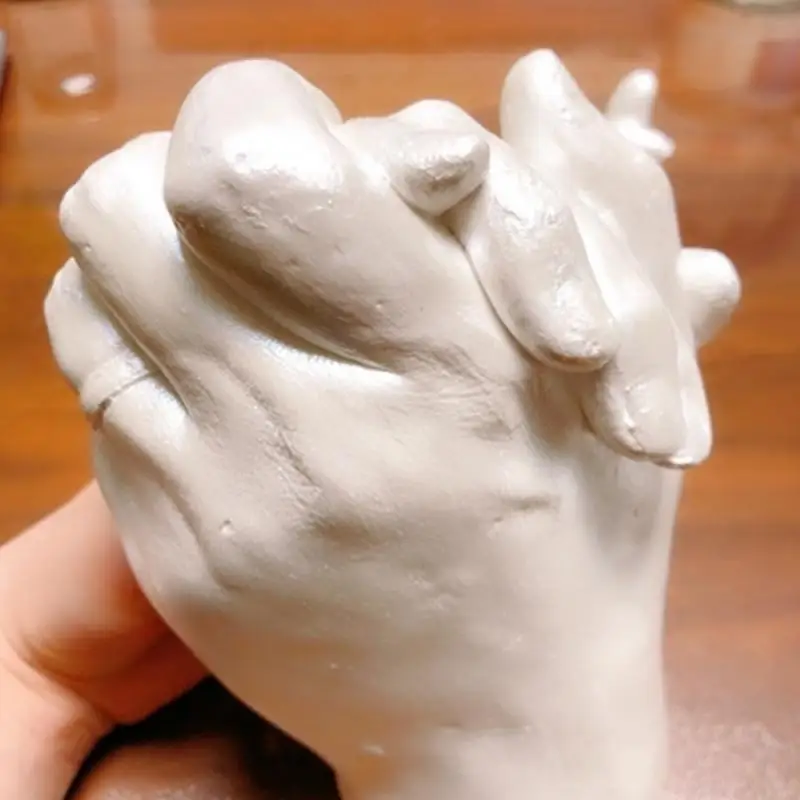
DIY kits for making 2D and 3D casts
Recently, a copied souvenir plaster hand has been popular with the townsfolk. How to make it with your own hands is described in detail in the instructions for ready-made kits for modeling. Such a kit is ideal for those who want to try their hand at volumetric casting, but do not have the opportunity or do not want to understand the brands of molding masses and gypsum.
The kit will cost more than separately purchased components. But manufacturers are focusing on the convenience of such a configuration. In addition, they give a guarantee of the quality of their materials. The kit includes a dry hypoallergenic mass for forms, it is easy to prepare it by filling it with water in the required ratio. There is also a model cleaned gypsum of increased strength.
Casting kit for simple hand or foot impressions includes reusable plastic molding compound. Before use, it is kneaded, an impression is made and plaster is poured into it.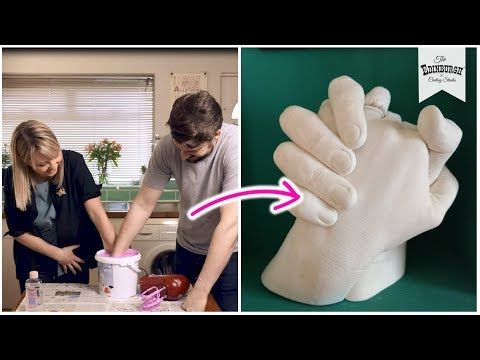 After solidification, the casting is removed. If re-filling is not expected, the mold is again kneaded to a soft state and set aside for storage, packed in a plastic bag.
After solidification, the casting is removed. If re-filling is not expected, the mold is again kneaded to a soft state and set aside for storage, packed in a plastic bag.
Finishing
How to make a plaster cast of a hand into a finished composition? To do this, it must be painted. For some, the ideal option would be toning with gold or bronze paint. Another will choose a skin tone or white.
Acrylic emulsion is suitable for decorative coating, but its layer, although thin, can smooth out fine lines and wrinkles on the impression. Although, if the copy turned out to be imperfect, then this option is quite suitable. If you need to preserve the smallest details, it is better to use spray paint.
Before finishing, the cast is inspected, all irregularities are polished, defects are corrected. In order for the paint to lay down in an even layer, the workpiece can be pre-primed, allowed to dry and then sanded again with fine sandpaper.
For installation, select a decorative base of your choice and mount a copy of the hand or a composition with it on glue.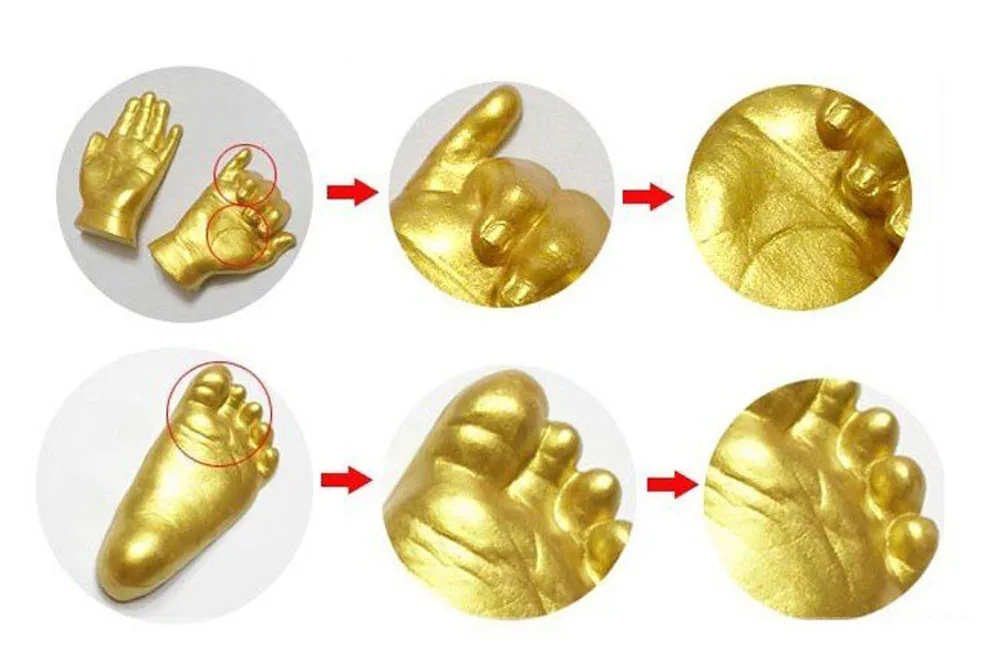 After drying, the souvenir can be varnished for greater effect.
After drying, the souvenir can be varnished for greater effect.
How to make your own plaster hand for copying?
Having mastered the technology of casting and making molds, you can try to expand the range of products. A copied plaster hand, made with your own hands, can serve as a detail of the original composition.
For example, if molded in the holding position, it can serve as a phone holder. In another case, it may be the base of a candlestick or table lamp. A decorative glass can be placed in a plaster hand and such a composition will turn into a pen holder or an original flower vase.
It is not practical to produce disposable forms for mass copying. In this case, elastic silicone is better. Forms from this material can be used repeatedly. To remove the casting, they are cut on one side and a copy is carefully removed.
The silicone is placed in the container in which it was poured during manufacture, and the process is repeated. For the convenience of extracting castings, you can use release agents. In such forms, you can pour not only gypsum, but also paraffin, tin or chocolate. The imagination of the authors is limitless - the main thing is not to be afraid to experiment!
In such forms, you can pour not only gypsum, but also paraffin, tin or chocolate. The imagination of the authors is limitless - the main thing is not to be afraid to experiment!
Nowadays, many parents make casts of children's hands and feet with their own hands. Such a commemorative imprint looks very cute and will allow you to remember the wonderful moments of early childhood for many years.
Do-it-yourself casts of children's hands and feet
- Step 1. Mix mold powder with water. You will get a paste, which must be transferred to the container where the impression will be made. Place an arm or a leg into the mass. The paste will begin to harden and take on a white color. Then, you must wait for about one minute for the mass to completely harden if water is used at room temperature;
- Step 2. Move your arm or leg to slide it out of the mold;
- Step 3. Mix plaster with water, making sure there are no lumps. Pour the mixture into the mold.
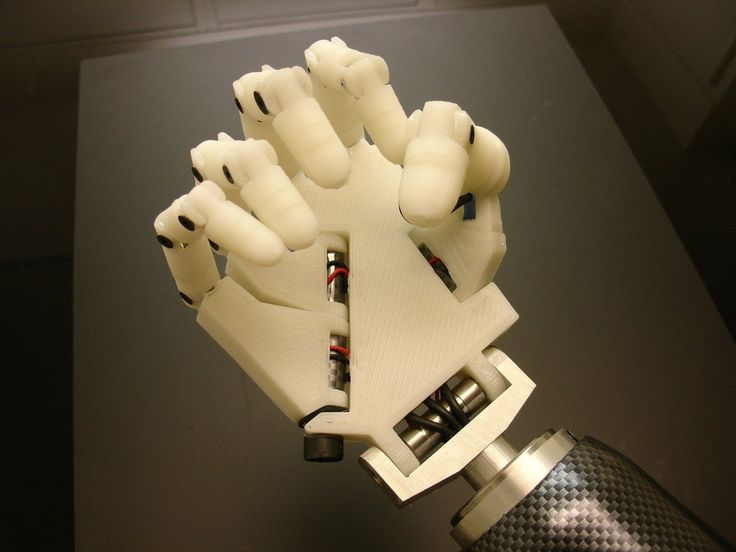 Leave the imprint for a while so that the gypsum hardens;
Leave the imprint for a while so that the gypsum hardens; - Step 4. Tear off or cut pieces of the mold to free the impression;
- Step 5. After drying, paint the impression in the chosen color or varnish. If you purchased a set with a frame or stand, glue it in place.
To make casts of arms and legs with your own hands, you do not need experience, you just need to carefully read the instructions. As a rule, kits contain all the necessary materials and tools. In addition, they often provide the opportunity to make several casts, because working with a child is completely unpredictable, and whether a perfect outline is obtained depends largely on our small models.
How to prepare for a do-it-yourself 3D impression of arms and legs:
- make your little model feel good;
- you can use sleep time;
- Mixture leftovers after making can be hard to wash off, so wear clothes you don't mind getting dirty;
- requires the participation of two adults - one to take care of mixing the ingredients, the second - to hold the baby and distract him;
- if you have touched the sides or bottom of the mold, you can pour plaster into it and then smooth out any imperfections with sandpaper;
- the time for which the form will completely harden depends on the temperature of the water used - the colder the water, the longer it will harden, the warmer the water - the faster the material will harden, room temperature of water is optimal;
- make sure the containers are the right size for your baby's feet or hands.
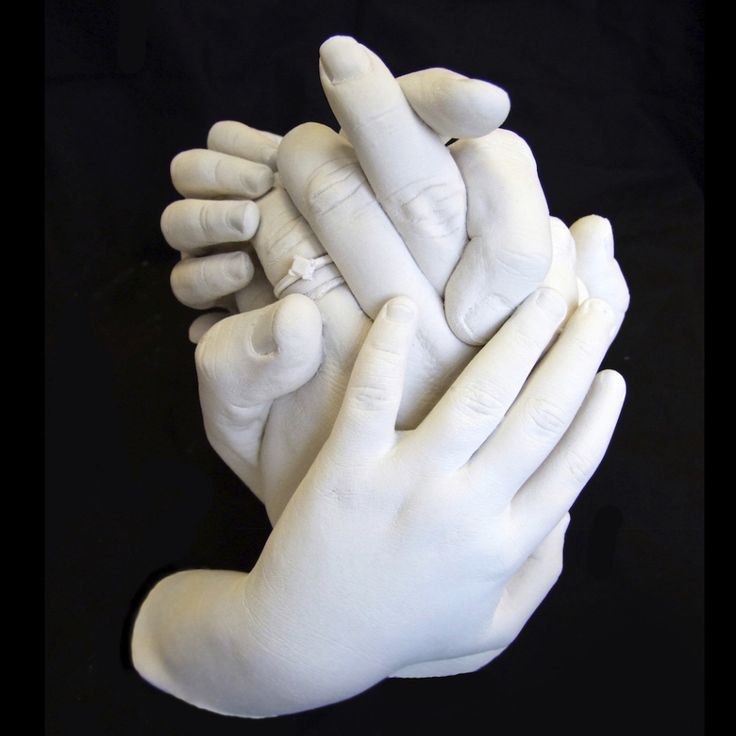
How to prepare a child to make a mold of children's hands and feet with their own hands
Take advantage of the moment when the little models are calm, it can be a moment of sleep or watching a cartoon. Some dormouse can oversleep all the fun and do not even notice what is happening around them.
However, if the child is sensitive to cold, it is important to pre-moisten the hands or feet with water to allow the child to get used to the temperature of the mass.
If this does not help, you can add warm water, but keep in mind that the higher the temperature, the faster the mass will set.
In this case, you can add a little more water than indicated in the instructions or fill up not all the contents of the bag.
If you want to make a casting mold while your baby is awake, you should definitely find a moment when the baby is in a good mood, calm, full and well-rested. Prepare an attractive toy, book, or other entertainment to distract your baby.
Don't worry if your little one wiggles his toes a little, this will have a positive effect on the final result, allowing air bubbles to escape and the mass to get into the gaps between the fingers. If the child has moved their hand, try gently moving the container behind the hand. Of course, you can gently hold the handle, but remember to remain calm and not force the baby. Otherwise, the baby will receive unnecessary stress, and the quality of the print will be reduced. The mass hardens quickly, so just wait a little and everything will be ready.
Some children do not like having their leg or arm immobilized, then less water can be added to speed up the setting time. If the child does not respond well to the moment the arm or leg is immersed in the mass, it is recommended to wait a while. eg 2 weeks and try again.
How to prepare molds for making casts for children with your own hands
To make an impression with your own hands, mix the mold powder with water in any container and pour into a closed plastic container, you can mix the mixture directly in the same container.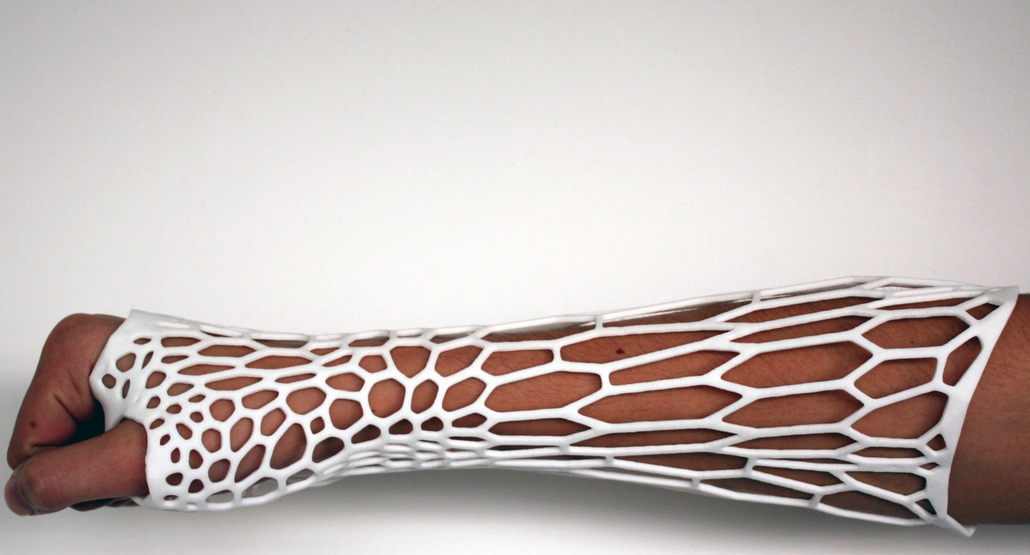 Be sure to measure the ingredients accurately as a poor ratio can affect the final result. You can use the test sample, which is sometimes included with the kit, to have information about the curing process.
Be sure to measure the ingredients accurately as a poor ratio can affect the final result. You can use the test sample, which is sometimes included with the kit, to have information about the curing process.
Thoroughly wet the skin of children's feet or hands so that they easily slide out of the hardened mold.
Thanks to this manipulation, your child will be able to get used to the mass temperature, in addition, we will minimize the risk of air bubbles that impair the quality of the product. Guide the baby's hand so that it slides accurately and gently into the prepared paste.
Don't worry if your child moves the handle. The beginning of the hardening process will show a change in the color of the paste, and this is the point at which the child should not make very sudden movements. After hardening (about 1-1.5 minutes), remove the handle. To avoid holes in the hardened form, guide the child's hand without touching the bottom or sides of the container.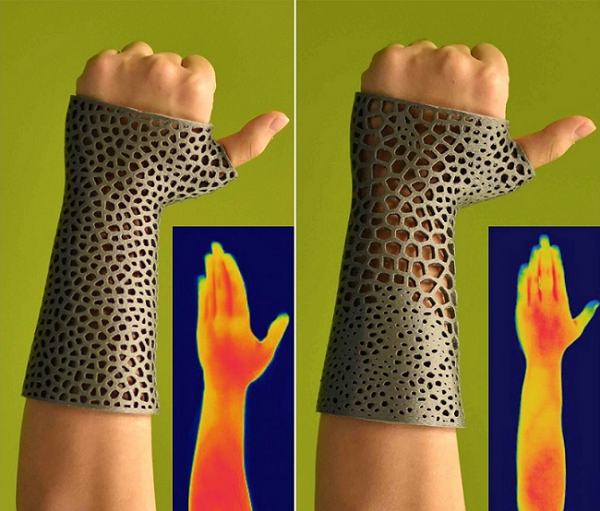
How to prepare and pour plaster
Plaster casting should not last longer than 5-6 minutes.
- Prepare a plastic bowl, measure out the required amount of water and gypsum in the appropriate proportions. Always add powder to water, not the other way around;
- Pour the gypsum into the water slowly, with constant stirring, until the mass reaches the consistency of a very thin yoghurt. Too intensive and long mixing can lead to the fact that the mass begins to harden already during pouring into the mold. Also, too much agitation can cause bubbles to form. If you see bubbles on the surface, tap the container a few times to get them out;
- The plaster is initially very watery, but after a while it gently begins to thicken. Gypsum is ready when it reaches the consistency of pancake dough. Then, pour a small amount of gypsum into the mold and carefully move the container in different directions so that the mass fills exactly each hole;
- After filling the form 1/3, tap the container on the table surface;
- Pour the remainder of the mass in batches;
- Leave the container to harden for several hours.

How to avoid air bubbles in plaster?
Air bubbles spoil bulk impressions, as a result, the plaster does not reach the fingertips, and the impression will not completely repeat the child's hand. This problem mostly occurs with pen impressions, as the fingers are longer on them than on the toes, and the plaster does not always flow well into these holes.
You can use the following methods to avoid this:
- do not stir the gypsum mixture too long;
- Tap the plaster container hard and repeatedly on the table;
- prick large blisters that appear on the surface;
- first pour a small amount of plaster and move it in different directions so that it spreads evenly throughout the mold;
- Pour the mass along the walls, holding the container with the mold at an angle - if the mold is in a vertical position and you pour from above, there is a risk that the mass will not fill the holes to the fingertips;
- in the case of legs, if you fill half the mold, you can take a brush and spread the mass with it;
- for handles, tilt the mold with your fingers down so that the mass flows there.

In what position is it most convenient to make 3D impressions
0-5 months. For the smallest children, it is necessary to carry out the procedure in a supine position, as for feeding.
Friends, a small introduction!
Before reading the news, let me invite you to the largest community of 3D printer owners. Yes, yes, it already exists, on the pages of our project!
20 years ago, law enforcement used fingerprints to identify criminals. Today they are used in a wide variety of civil and commercial areas of life.
2D synthetic fingerprint generators produce fingerprint patterns based on mathematical and statistical models. To improve a fingerprint scanning system, researchers must compare millions of images of known fingerprints. However, their actions are limited by the amount of data available. Also, 2D synthetic generators make mistakes when testing non-contact fingerprint recognition technologies, which are increasingly being used as an alternative to traditional touch screen fingerprint systems.
To solve this problem, a team of programmers from Michigan State University led by Enil Jain, a graduate of the Indian Institute of Technology (IIT) Kanpur, created the world's first 3D printed fingerprint.
The use of such 3D printed fingerprints could help sensor manufacturers and algorithm developers improve hardware and software for fingerprint matching systems, says Anil Jain. Ultimately, it can lead to security improvements.
Jain, emeritus professor of computer engineering, and his team have succeeded in developing a method for transferring a 2D fingerprint image onto a 3D surface.
A 3D printed print with all the bumps and indentations of a normal human fingerprint is printed on a 3D printer. Jane's team called him a "phantom".
Such phantoms are very common in the world of medical imaging. For example, to make sure that an MRI or CT machine is working correctly, you first need to take data from an object whose parameters and properties are well known. “You can 3D print a heart or a kidney,” Jane says. “Since the parameters are already known, they can be loaded into the scanner and the imaging system can be set up.”
“You can 3D print a heart or a kidney,” Jane says. “Since the parameters are already known, they can be loaded into the scanner and the imaging system can be set up.”
In this case, the main goal is to obtain an accurate fingerprint model with known properties and pattern, which can be used in customizing the existing technology that is used in fingerprint matching.
“When I see this 3D printed fingerprint phantom in front of me, I know its exact dimensions,” Jane explains. “And since I know its exact parameters, I can better set up the fingerprint reader.”
Although the 3D printed model does not yet have the exact texture or surface of a real finger, it may well advance the technology of reading and matching fingerprints.
"Tools like these will help improve the overall accuracy of fingerprint matching systems, which in turn will improve security in everything from law enforcement to mobile phone unlocking," says Jane. For example, iPhone 5s can be unlocked using Touch ID.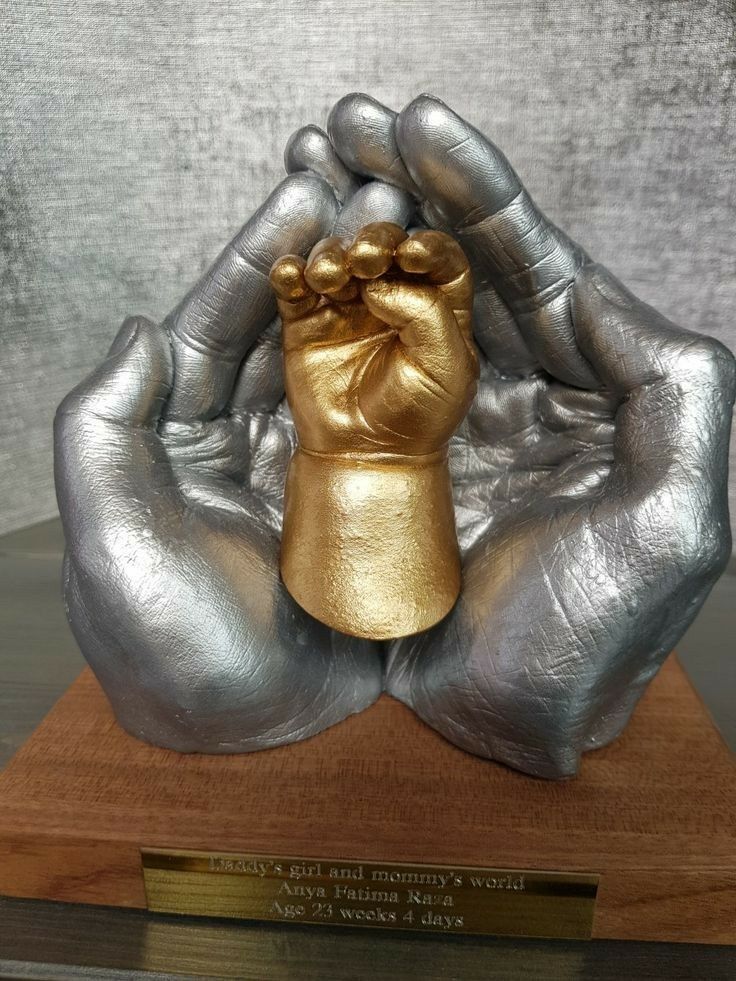
Jane holds six US patents for fingerprint matching. He also wrote a number of books on biometrics and person identification by face and fingerprints.
Zdravprint 3D printed orthoses replace plaster casts
Business
The Russian company Zdravprint has received $100,000 from venture capital fund Maxfield Capital to develop 3D printed orthoses. The idea is, of course, a good one. Plastic retainers have a number of advantages over traditional gypsum: they are not afraid of moisture, allow the skin to breathe and are more hygienic. Scanning, on the other hand, makes it possible to print orthoses that perfectly follow the contours of the injured limb.
If you've ever had a fracture, you know how frustrating it is to wear a cast for a couple of months. Not only are such casts heavy and uncomfortable, but the skin under them itches and even becomes inflamed. In addition, gypsum absorbs water, which creates additional problems when bathing.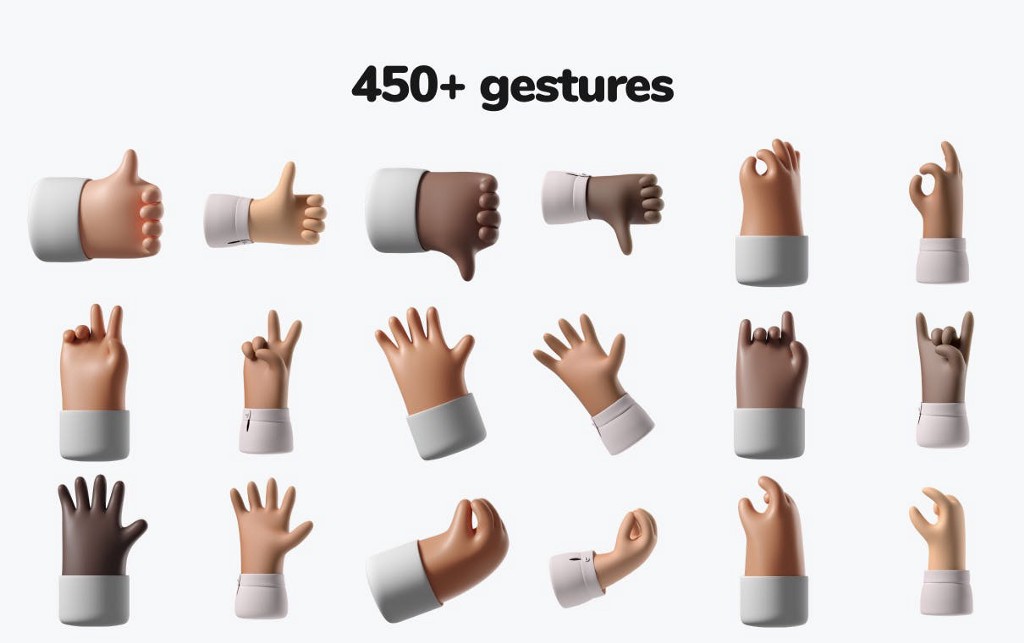 Zdravprint is trying to solve all these problems in one fell swoop, replacing plaster with plastic orthoses that have been printed to meet the needs of specific patients.
Zdravprint is trying to solve all these problems in one fell swoop, replacing plaster with plastic orthoses that have been printed to meet the needs of specific patients.
The company was founded by Fedor Aptekarev, Alexander Cherkasov and Sabina Sakaeva. Orthosis developers took part in Yandex's Tolstoy Startup Camp courses, a program aimed at helping to implement new ideas and launch startups. It was there that Fyodor, who is fond of skateboarding and knows all the “charms” of gypsum fixatives firsthand, came up with the idea to try out 3D printing of medical splints.
As Sabina admits, Zdravprint's first development is unoriginal: it almost exactly repeats Deniz Karahasin's "Osteoid Medical" splint, which in turn is based on the work of Jack Evill from the University of Victoria at Wellington. Evill's brace, called the "Cortex", proved impractical due to its monolithic construction, but a start was made. Karahasin created a more practical design, and even added ultrasonic emitters to stimulate bone regeneration, but his project used a rather toxic ABS plastic, and therefore could not qualify for medical certification. Of course, the same tires can be printed from organic, safe PLA plastic, which is what the guys from Zdravprint did.
Of course, the same tires can be printed from organic, safe PLA plastic, which is what the guys from Zdravprint did.
Now, the team is considering ways to commercialize their ideas. The company has applied for a patent and is also working on obtaining the necessary certification to sell its products in medical institutions. In addition, the company is considering the creation of specialized software and the sale or licensing of software along with 3D printers and scanners. The latter option may be the most practical for widespread adoption of the technology. Of course, the team did not limit themselves to designing one design, but creates a whole line of orthoses and fixators to treat all kinds of injuries.
The process of creating an individual orthosis is quite simple and is a standard cycle of scanning, processing a digital model and printing a finished product. There is really one “but”: before using a plastic splint, the patient will still have to walk in a cast, because fixation with plaster casts allows doctors to put broken bones in place with high accuracy.


